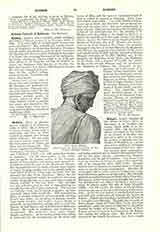

Robbia, LUCA DI SIMONE DELLA, sculptor, b. at Florence, 1400; d. 1481. He is believed to have studied design with a goldsmith, and then to have worked in marble and bronze under Ghiberti. He was early invited to execute sculptures for the Cathedral of S. Maria del Fiore and the Campanile. The latter—representing Philosophy Arithmetic, Grammar, Orpheus, and Tubalcain (1437)—are still somewhat Gothic in character. For the organ-gallery of the cathedral he made the famous panels of the Cantorie, groups of boys singing and playing upon musical instruments (1431-8), now in the Museo del Duomo. For the north sacristy he made a bronze door; figures of angels bearing candles and a fine glazed earthen-ware relief of Christ rising from the tomb over the entrance are also of his execution. Above the entrance to the southern sacristy he made the Ascension (1446) . From this time on, Luca seems to have worked almost entirely in his new ware. The medium was not unknown, but by dint of experimenting he brought his material to great perfection. The colors are brilliant, fresh, and beautiful in quality, the blue especially being quite inimitable. The stanniferous glaze, or enamel, contained various minerals and was Luca’s own secret; in the firing, it became exceedingly hard, durable, and bright. Luca’s design is generally an architectural setting with a very few figures, or half figures, and rich borders of fruits and leaves of lilies, and the eyes; an occasional touch of gold is added in coronal or lettering. Later Luca used color more freely. The Della Robbia earthen-wares are so fresh and beautiful and so decorative that even in Luca’s time they were immediately in great request. They are seen at their best in Florence. A few of the principal ones are: the crucifix at S. Miniato and the ceiling of the chapel in which it is found; the medallions of the vault (center, the Holy Ghost; corners, the Virtues) in the chapel of Cardinal Jacopo of Portugal, also at S. Miniato; the decorations of the Pazzi chapel at Sta. Croce; the armorial bearings of the Arti at Or San Michele; the Madonna of S. Pierino; the exquisite street lunette of Our Lady and Angels in the Via dell’ Agnolo; the tomb of Bishop Benozzo Federighi at the Sta. Trinita; and, in the Bargello, the Madonna of the Roses, the Madonna of the Apple, and a number of equally fine reliefs. Of his works outside Florence may be mentioned: the Madonna at Urbino; the tabernacle at Impruneta, the vault panels of S. Giobbe, Venice (sometimes said to be by the school only); medallions of Justice and Temperance, Museum of Cluny, Paris; arms of Rene d’Anjou, London, South Kensington Museum, and other works in Naples, Sicily, and elsewhere. The admirable and much disputed group of the Visitation at S. Giovanni Fuorcivitas, Pistoia, is attributed both to Luca and to Andrea.
M. L. HANDLEY

